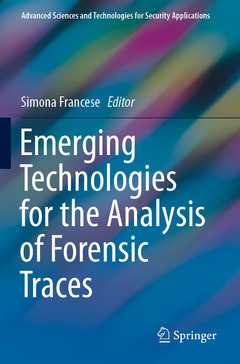Emerging Technologies for the Analysis of Forensic Traces, 1st ed. 2019 Advanced Sciences and Technologies for Security Applications Series
Coordonnateur : Francese Simona

This book provides a line of communication between academia and end users/practitioners to advance forensic science and boost its contribution to criminal investigations and court cases. By covering the state of the art of promising technologies for the analysis of trace evidence using a controlled vocabulary, this book targets the forensics community as well as, crucially, informing the end users on novel and potential forensic opportunities for the fight against crime.
By reporting end users commentaries at the end of each chapter, the relevant academic community is provided with clear indications on where to direct further technological developments in order to meet the law requirements for operational deployment, as well as the specific needs of the end users.
Promising chemistry based technologies and analytical techniques as well as techniques that have already shown to various degrees an operational character are covered. The majority of the techniques covered have imaging capabilities, that is the ability to visualize the distribution of the target molecules within the trace evidence recovered. This feature enhances intelligibility of the information making it also accessible to a lay audience such as that typically found with a court jury. Trace evidence discussed in this book include fingermarks, bodily fluids, hair, gunshot residues, soil, ink and questioned documents thus covering a wide range of possible evidence recovered at crime scenes.
Mass spectometry methods for the recovery of forensic intelligence from fingermarks; M.J. Bailey, C. Costa, End User Commentary: S.M. Bleay.- Novel technological applications for latent and blood-stained fingermark ageing studies; J. De Alcaraz-Fossoul, M. Islam, End User Commentary: Aldo Mattei.- Bioanalytical Advancements in the Reliable Visualization and Discrimination of Bodily Fluids; J. Gooch et al., End User Commentary: C. Gannicliffe.- Investigating the age of blood traces: how close are we to finding the holy grail of forensic science?; M. Aalders, L. Wilk, End User Commentary: C. Gannicliffe.- Recent technological developments in MALDI-MSI based hair analysis; B.Flinders et al.,End User Commentary: E. Cuypers.- Emerging approaches in the analysis of inks on questioned documents; C. Weyermann, End User Commentary: A.C. Almeida Assis.- Advances in Analysis of Gunshot Residue;F. Saverio Romolo, End User Commentary: S. Charles.- Advances in the analysis of explosives; F. S. Romolo, A. Palucci, End User Commentary: W. Greibl.- The Application of Forensic Soil Science in Case work and Legal Considerations; L. Dawson et al.; End User Commentaries: L. Van den Eijkel , P. Campbell.
Simona Francese holds a degree in Chemistry awarded by the University of Salerno (Italy) in 2000 by successfully completing a 5 year programme Upon successful completion of further chemistry exams, she was awarded the “abilitation to undertake the profession of Chemist” by the same University.
She was subsequently awarded a PhD in Chemical Sciences in 2004 by the University of Salerno by successfully completing a 3 year research programme. PhD achieved excellence as ratified by the awarding academic panel. Francese was awarded a short post doctoral fellowship between March 2005 and June 2015 and subsequently held a 3 year research fellowship at the Interdepartmental Centre for Mass Spectrometry, University of Florence, Italy.
She was then employed at Sheffield Hallam University in 2008 as Lecturer in Biomedical Sciences.
At Sheffield Hallam University (SHU), Dr Francese is Reader since 2014 and the deputy Head of the Centre for Mass Spectrometry Imaging since 2016 within the Biomolecular Research Centre. At SHU She has pioneered the use and development of MALDI MSI strategies to extract additional intelligence from latent fingermarks starting October 2008. She is part of the International Fingermark Research Group (40 members worldwide on invitation only) and currently the worldwide leader in the application of this technology to ridge impressions, publishing 17 peer reviewed papers to date.
Together with the group that she leads, she has built unprecedented knowledge on the use of MALDI MS based strategies to derive additional forensic intelligence from the chemical content of a mark; this ranges from specific detection of blood through detection of haemoglobin and haem, determination of the suspect's sex, separation of overlapping marks, to the detection of ingested substances and external contaminants including drugs of abuse making possible the integration with currently employed forensic workflows. She leads multidisciplinCovers the state of the art of emerging cutting edge technologies holding the promise for operational deployment
Presents topics in a controlled vocabulary enabling access to a wider range of readers
Reports the viewpoint of end users in relation to each technology covered and applied to specific types of trace evidence
Commentary covers potential operational capabilities and possible present incompatibilities with Law Requirements
Date de parution : 10-2020
Ouvrage de 275 p.
15.5x23.5 cm
Disponible chez l'éditeur (délai d'approvisionnement : 15 jours).
Prix indicatif 105,49 €
Ajouter au panierDate de parution : 10-2019
Ouvrage de 275 p.
15.5x23.5 cm
Disponible chez l'éditeur (délai d'approvisionnement : 15 jours).
Prix indicatif 105,49 €
Ajouter au panierThème d’Emerging Technologies for the Analysis of Forensic Traces :
Mots-clés :
Criminal profiling through fingermark analysis; Body fluid smart detection and discrimination; Detection of drugs and metabolites in hair; Soil analysis; Ink and questioned document analysis; Detection of gunshot residues; Trace evidence analysis; Trace evidence vocabulary; Forensic analysis technology
